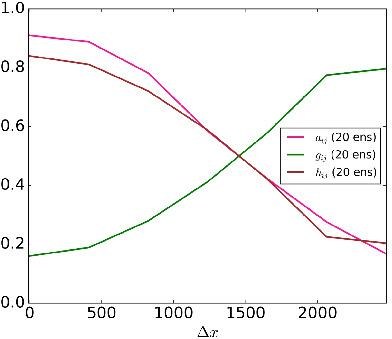当前位置:
X-MOL 学术
›
Q. J. R. Meteorol. Soc.
›
论文详情
Our official English website, www.x-mol.net, welcomes your
feedback! (Note: you will need to create a separate account there.)
Empirical determination of the covariance of forecast errors: An empirical justification and reformulation of hybrid covariance models
Quarterly Journal of the Royal Meteorological Society ( IF 3.0 ) Pub Date : 2021-02-20 , DOI: 10.1002/qj.4008 D. S. Carrió 1, 2 , C. H. Bishop 1, 2 , S. Kotsuki 3, 4, 5
Quarterly Journal of the Royal Meteorological Society ( IF 3.0 ) Pub Date : 2021-02-20 , DOI: 10.1002/qj.4008 D. S. Carrió 1, 2 , C. H. Bishop 1, 2 , S. Kotsuki 3, 4, 5
Affiliation

|
During the last decade, the replacement of static climatological forecast error covariance models with hybrid error covariance models that linearly combine localised ensemble covariances with static climatological error covariances has led to significant forecast improvements at several major forecasting centres. Here, a deeper understanding of why the hybrid's superficially ad hoc mix of ensemble‐based and climatological covariances yields such significant improvements is pursued. In practice, ensemble covariances are not equal to the true flow‐dependent forecast error covariance matrix. Here, the relationship between actual forecast error covariance and the corresponding ensemble covariance is empirically demonstrated. Using a simplified global circulation model and the local ensemble transform Kalman filter (LETKF), the covariance of the set of actual forecast errors corresponding to ensemble covariances close to a fixed target value is computed. By doing this for differing target values, an estimate of the actual forecast error covariance as a function of ensemble covariance is obtained. A demonstration that the hybrid is a much better approximation to this estimate than either the static climatological covariance or the localised ensemble covariance is given. The empirical estimate has two features that current hybrid error covariance models fail to represent: (i) The weight given to the static covariance matrix is an increasing function of the horizontal separation distance of the covarying model variables, and (ii) for small ensemble sizes and ensemble covariances near zero but negative, the actual forecast error covariance is a decreasing function of increasing ensemble covariance. While the first finding has been anticipated by other authors, the second finding has not been anticipated, as far as the authors are aware. Here, (ii) is hypothesised to be a consequence of spurious sample correlations and variances associated with reduced ensembles. Consistent with this hypothesis, the non‐monotonicity of this relationship is almost eliminated by quadrupling the ensemble size.
中文翻译:

预测误差的协方差的经验确定:混合协方差模型的经验论证和重新制定
在过去的十年中,用混合误差协方差模型代替了静态气候预测误差协方差模型,该模型将局部集成整体协方差与静态气候误差协方差线性地结合在一起,从而在几个主要的预测中心显着改善了预报。在这里,更深入地了解了为什么混合动力的表面特设基于集合和气候协方差的混合产生了如此显着的改善。在实践中,整体协方差不等于真实的流量相关的预测误差协方差矩阵。在此,通过经验证明了实际预测误差协方差与相应的整体协方差之间的关系。使用简化的全局环流模型和局部集成变换卡尔曼滤波器(LETKF),可计算出与整体协方差相对应的,接近固定目标值的实际预测误差集的协方差。通过对不同的目标值执行此操作,可以得出实际预测误差协方差作为整体协方差的函数的估计值。给出了一个证明,即与静态气候协方差或局域整体协方差相比,杂合是对该估计值更好的近似值。经验估计具有两个特征,当前的混合误差协方差模型无法表示:(i)赋予静态协方差矩阵的权重是协变模型变量的水平分隔距离的递增函数,以及(ii)对于较小的整体大小并且总体协方差接近零但为负,则实际的预测误差协方差是整体协方差增加的递减函数。据作者所知,虽然其他作者已经预料到了第一个发现,但并未预料到第二个发现。这里,假设(ii)是与减少的合奏相关的虚假样本相关性和方差的结果。与此假设相一致,通过将集合大小增加四倍,几乎消除了这种关系的非单调性。
更新日期:2021-02-20
中文翻译:

预测误差的协方差的经验确定:混合协方差模型的经验论证和重新制定
在过去的十年中,用混合误差协方差模型代替了静态气候预测误差协方差模型,该模型将局部集成整体协方差与静态气候误差协方差线性地结合在一起,从而在几个主要的预测中心显着改善了预报。在这里,更深入地了解了为什么混合动力的表面特设基于集合和气候协方差的混合产生了如此显着的改善。在实践中,整体协方差不等于真实的流量相关的预测误差协方差矩阵。在此,通过经验证明了实际预测误差协方差与相应的整体协方差之间的关系。使用简化的全局环流模型和局部集成变换卡尔曼滤波器(LETKF),可计算出与整体协方差相对应的,接近固定目标值的实际预测误差集的协方差。通过对不同的目标值执行此操作,可以得出实际预测误差协方差作为整体协方差的函数的估计值。给出了一个证明,即与静态气候协方差或局域整体协方差相比,杂合是对该估计值更好的近似值。经验估计具有两个特征,当前的混合误差协方差模型无法表示:(i)赋予静态协方差矩阵的权重是协变模型变量的水平分隔距离的递增函数,以及(ii)对于较小的整体大小并且总体协方差接近零但为负,则实际的预测误差协方差是整体协方差增加的递减函数。据作者所知,虽然其他作者已经预料到了第一个发现,但并未预料到第二个发现。这里,假设(ii)是与减少的合奏相关的虚假样本相关性和方差的结果。与此假设相一致,通过将集合大小增加四倍,几乎消除了这种关系的非单调性。











































 京公网安备 11010802027423号
京公网安备 11010802027423号